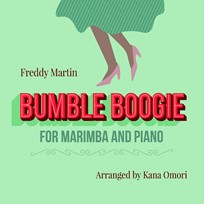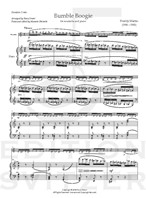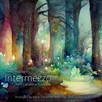
Bumble Boogie
Composer: Freddy Martin
Instrument: Marimba and Piano
Level: Intermediate/Advanced
Published: 2018
Price: €20.00
Item details
-
Description +
-
Duration: 3 min.
Arranged by Kana Omori
-
-
Instrumentation +
-
Marimba and Piano
-
-
Watch+
-
Performed by Manami Shiraishi (piano) and Kana Omori (marimba)
-
-
About the composer +
-
Frederick Alfred Martin (December 9, 1906 – September 30, 1983) was an American bandleader and tenor saxophonist.
Freddy Martin was born in Cleveland, Ohio. Raised largely in an orphanage and by various relatives, Martin started out playing drums, then switched to C melody saxophone and subsequently tenor saxophone, the latter the one with which he would be identified. Early on, he had intended to become a journalist. He had hoped that he would earn enough money from his musical work to enter Ohio State University, but instead, he wound up becoming an accomplished musician. Martin led his own band while he was in high school, then played in various local bands. Freddy spent his spare time selling musical instruments; which also gave him an excuse to listen to the Lombardos play at the "Music Box". After working on a ship's band, Martin joined the Mason-Dixon band, then joined Arnold Johnson and Jack Albin. It was with Albin's "Hotel Pennsylvania Music" that he made his first recordings, for Columbia's Harmony, Velvet Tone, and Clarion 50-cent labels in 1930.
-
-
Reviews +
-
Review (Percussive Notes, June 2020)
“Bumble Boogie” was written by Alfred Martin and recorded by Freddie Martin and His Orchestra with pianist Jack Fina in 1946. It is an adaptation of Rimsky-Korsakov’s “The Flight of the Bumblebee.” Kana Omori created this arrangement for marimba and piano.
The piano and marimba parts are both packed with fast, chromatic runs. The piece begins with the familiar sounds of “The Flight of the Bumblebee.” The marimbist and pianist trade melody and accompaniment in varying stretches of the section. The B section is more syncopated and, dare I say, groovy. The initial character of the music is still preserved. However, about halfway through the piece, the indication in the score is “Tempo boogie-woogie.” That style permeates the rest of the piece. Both parts are quite challenging throughout and require strong ensemble skills to stay together.
This is a fun and exciting piece that audiences will love. Lasting about three minutes, it would work perfectly as a recital closer or encore. A challenging, but worthwhile undertaking!
—Justin Bunting
-









